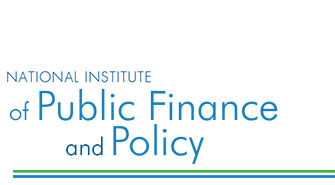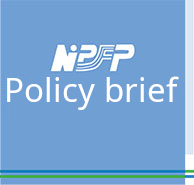Macroeconomic Forecasts and Fiscal Policy Challenge
SUDIPTO MUNDLE, Chairman, Centre for Development Studies. email:
RUDRANI BHATTACHARYA, Associate Professor, National Institute of Public Finance and Policy, New Delhi, India. email:rudrani.bhattacharya@nipfp.org.in
DINESH KUMAR NAYAK, Economist, National Institute of Public Finance and Policy, New Delhi, India. email:dinesh.nayak@nipfp.org.in
|
1. Growth and Inflation Projections
Growth
The Indian economy grew by 8.7% in FY 2021-22. However, this apparently robust growth was mainly attributable to the base effect of a pandemic driven (-) 6.6% contraction in 2020-21. The level of economic activities in 2021-22 was actually just 1.6 percent higher than the pre-pandemic activity level of 2019-20, implying an average annual growth rate of only 0.8% for the two year period 2020-22. These comparisons point to the potentially misleading conclusions that can be drawn from focusing on growth rates alone, especially when the level of activity is impacted by major positive or negative shocks, like the Covid 19 pandemic. This point is best illustrated at a more disaggregated level by the growth rates of the sector ‘Trade, Hotels and Transport Services’. Thanks to the base effect of the contraction in 2020-21, this sector registered very robust double digit growth in 2021-22. However, the level of output in the sector in 2021-22 was actually lower compared to the pre-pandemic level of 2019-20 (Table 1).
Though the pandemic effect had considerably waned by FY 2021-22, the deadly Delta variant of Covid 19 had a major adverse effect on economic activity levels in Q1 of FY 2021-22. The base effect of this slowdown in Q1 FY2021-22 is reflected in the high GDP growth of 13.5% growth in Q1 of FY 2022-23. The key question is how growth is likely to play out during the rest of the current financial year. Our high frequency indicators-based forecasting model, indicates that the economy will grow at rates of 5.9%, 4.7% and 6% during Q2, Q3 and Q4 of 2022-23 respectively, with an annual growth rate of 7.3% in FY 2022-23 (Figure 1 and Table 2). This compares with the latest growth projections of 7.2%, 7.4% and 7.5% respectively by RBI, IMF and the World Bank. Growth projections by most other official and private agencies are similar, implying that there is a wide consensus that the Indian Economy will grow at 7% -7.5% during FY 2022-23.
Table 1: Aggregate and sectoral GDP from 2019-20 to 2021-22 (Rs Trillions)
Source: CSO; Numbers in parentheses indicate growth rates
Figure 1: Growth Projected at 7.3% for FY 2022-23
Source: CSO; Bhattacharya, Bhandari & Mundle, (October 2021), “Nowcasting India’s Quarterly GDP Growth: A Factor Augmented Time-Varying Coefficient Regression Model (FA-TVCRM)”, NIPFP Working Paper No. 357).
Table 2 Quarterly and annual growth projections
Source: CSO; Bhattacharya, Bhandari & Mundle, (October 2021)
Growth in the range of 7-7.5% in 2022-23 will imply the India is the fastest growing economy among economies in Asia and other major emerging market economies (Table 3). However, it has to be noted that the RBI has significantly changed its accommodative monetary policy since May, 2022 in view of rising inflationary pressures, as is discussed further below. There are also several adverse developments especially on the external front in recent months. Whether the present growth projections by us and others adequately reflect these developments remains to be seen. Further, even if our growth forecasts are realized, stripping out the base effect on Q1 2022-23 growth, the average growth for the subsequent three quarters amounts to only 4.8%. This is just a shade above the 4.4% growth IMF has forecast for China in 2022 and much below the 6.3% growth the Indian economy was averaging up to 2019-20. It implies that even if the present pace of economic recovery is sustained, the level of economic activity will remain well below the normal level that would have prevailed if the pre-pandemic growth path had been maintained.
Table 3 Growth and inflation in selected countries
Source: International Monetary Fund, World Economic Outlook Database, April 2022
Inflation
Headline inflation breached the upper limit of RBI’s inflation tolerance band of 6% in January 2022 and continuously increased to 7.8% in April 2022. This was on account of rising food price inflation along with high energy price inflation and high and sticky core inflation. Food price inflation has been driven by cost-push factors such as agricultural wage inflation, increase in Minimum Support Prices, adverse weather shocks and rising global edible oil prices inflation. For core items, a broad-based rise in inflation can be observed since the beginning of FY 2021-22. Global oil price inflation, combined with policy induced demand revival and continuing pandemic-induced supply side disruptions have been driving core inflation.
Our forecast is that headline inflation will remain elevated at 6.4% in 2022-23 (Figure 2).
Figure 2: Headline inflation projected at 6.4% in FY 2022-23
Source: CSO; Bhattacharya & Kapoor (2020), “Forecasting Consumer Price Index Inflation in India: Vector Error Correction Mechanism Vs. Dynamic Factor Model Approach for Non-Stationary Time Series”, NIPFP Working Paper No. 323.
Our quarterly and annual inflation projections along with the comparable RBI projections are presented in Table 4. Both sets of projections indicate that headline inflation is likely to stay well above the upper limit of RBI’s tolerance band of 6% during FY 2022-23. Taken together with the subdued growth outlook discussed earlier, this poses a serious macroeconomic policy challenge. This issue is discussed further below.
|
Table 4 Quarterly & annual Inflation Projections
Source: CSO; Bhattacharya & Kapoor (2020)
2. Revenue Projection for 2022-23
With real growth forecast of 7.3% and headline inflation forecast at 6.4%, we project that the economy will grow at 13.7 % in nominal terms, reaching a nominal GDP level of Rs.269 trillion in FY 2022-23 (Figure 3).
Figure 3: GDP from 2015-16 to 2022-23
Source: CSO; P-Provisional, Budget at a Glance 2022-23; *Authors’ Projection
Applying tax revenue buoyancies to the projected nominal GDP estimates we arrive at tax revenue projections for FY 2022-23. The estimated tax revenue buoyancies with respect to GDP are presented in Table 5. Centre’s total tax revenue collection in 2022-23 is projected at Rs 19.75 trillion, which is higher than the budget estimate of Rs. 19.35. trillion (Figure 4).
Table 5: Buoyancy Estimates of Tax Revenue Components
Source: RBI Central Govt. Receipts, Major Components; Budget at a Glance, Government of India; Authors’ Estimation
Note: Buoyancy estimated based on the period 2011-12 to 2019-20; Net: Central tax revenue net of States’ share
Figure 4: Centre's Total Tax Revenue
Source: Budget at a Glance, Government of India, various years
P: Provisional estimate, *Authors’ Projection
3. Fiscal policy outlook
The fiscal policy outlook has to be weighed against the background of subdued growth (after correcting for the base affect in Q1, 2022-23) and high inflation, above the upper end of RBI’s tolerance band as discussed earlier.
The high inflation and its impact on nominal GDP growth is helpful on the tax revenue side of the budget. As explained above, our projections show that Centre’s tax revenue resources will exceed the budget estimate by about Rs 0.4 trillion. Despite this, assuming that central expenditures are broadly in line with the budget estimates, the fiscal deficit for FY 2022-23 is likely to increase instead of being compressed as envisaged in the budget.
To project revenue receipts, buoyancy estimates for the two revenue components, estimated for the period 2011-12 to 2019-20 (Table 6), have been applied to our nominal GDP growth forecast. It is noted that the buoyancy components are not stable functions of nominal GDP. Nevertheless, they serve as useful first approximations for projecting revenues for the year 2022-23.
Table 6: GDP Buoyancy of Central Receipts
Source: Finance Accounts, CGA, Budget at a Glance, Government of India; and Authors’ Estimation; Buoyancy estimated for the period 2011-12 to 2019-20
Based on these computations, central tax revenue for the year 2022-23 is estimated at Rs 19.75 trillion. Another Rs 3.63 trillion is the estimated non-tax revenue plus a small component of Rs 0.14 trillion in non-debt capital receipts, yielding total non-debt receipts of Rs 23.52 trillion (Figure 5).
The centre’s total non-debt receipts and expenditure have been presented in Figure 6 to show the projected fiscal deficit for the year 2022-23 and compare it with recent trends. Centre’s tax revenue has grown steadily over the years, except for the contraction in 2020-21. Non-tax revenue declined from Rs. 3.27 trillion in 2019-20 to Rs 2.08 trillion in 2020-21, before recovering to Rs. Trillion 3.14 in 2021-22. It has been projected to increase further to Rs 3.63 trillion in 2022-23 (Figure 5). Adding the small component of non-debt capital receipts, total non-debt receipts (NDR) have grown more or less at par with nominal GDP, the ratio of NDR to GDP remaining stationary at around 8.6%. The expenditure ratio has been more volatile. It rose sharply in 2020-21 when the absolute level of spending was maintained despite the sharp fall in nominal GDP and non-debt receipts, leading to a large increase in the fiscal deficit. Expenditure was then sharply reduced relative to nominal GDP in 2021-22, prematurely in our view, in order to compress the deficit. As a result, the fiscal deficit which shot up to 9.2 % of GDP in 2020-21 was compressed to 6.7% in 2021-22 and is to be further reduced to 6.4% in the budget estimate for 2022-23. However, as per our projections, the fiscal deficit is likely to overshoot to nearly 7% of GDP in 2022-23 without additional compression measures.
Figure 5: Centre's Total Non-debt Receipts
Source: Finance Accounts, CGA, and Budget at a Glance, Government of India
Note: Figures in parenthesis are percentages of GDP;
P: Provisional, *Authors’ Projection.
That said, there is no room for complacency on the need for fiscal consolidation over the medium term. The combined fiscal deficit of the centre plus states is around 10% of GDP. In other words, debt equivalent to 10% of GDP is being added to the public debt stock each year, which is already around 90% of GDP. The interest cost of servicing that debt is the single largest carve out from the government budget, crowding out social and capital expenditure. Hence, accommodation of a larger deficit at present should be undertaken within a medium term framework of gradual fiscal consolidation.
|
|||||||||||||||||||||||||||||||||||||||||||||||||||||||||||||||||||||||||||||||||||||||||||||||||||||||||||||||||||||||||||||||||||||||||||||||||||||||||||||||||||||||||||||||||||||||||||||||||||||||||||||||||||||||||||||||||||||||||||||||||||||||||||||||||||||||||||||||||||||||||




